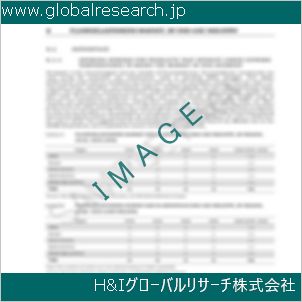1. Preface
1.1. Market Definition and Scope
1.2. Market Segmentation
1.3. Key Research Objectives
1.4. Research Highlights
2. Assumptions and Research Methodology
3. Executive Summary: Global Immunoassay Market
4. Market Overview
4.1. Introduction
4.1.1. Product Definition
4.1.2. Industry Evolution / Developments
4.2. Overview
4.3. Market Dynamics
4.3.1. Drivers
4.3.2. Restraints
4.3.3. Opportunities
4.4. Global Immunoassay Market Analysis and Forecast, 2017-2031
5. Key Insights
5.1. Pipeline Analysis
5.2. Key Product/Brand Analysis
5.3. Key Mergers & Acquisitions
5.4. COVID-19 Pandemic Impact on Industry
6. Global Immunoassay Market Analysis and Forecast, by Product
6.1. Introduction and Definitions
6.2. Key Findings/Developments
6.3. Market Value Forecast, by Product, 2017–2031
6.3.1. Analyzers
6.3.2. Consumables
6.4. Market Attractiveness, by Product
7. Global Immunoassay Market Analysis and Forecast, by Technology
7.1. Introduction and Definitions
7.2. Key Findings/Developments
7.3. Market Value Forecast, by Technology, 2017–2031
7.3.1. Chemiluminescence Immunoassay (CLIA)
7.3.2. Enzyme-linked Immunoassay (ELISA)
7.3.3. Enzyme-linked Immunofluorescent Assay (ELFA)
7.3.4. Radioimmunoassay (RIA)
7.3.5. Others
7.3.6. 7.4 Market Attractiveness, by Technology
8. Global Immunoassay Market Analysis and Forecast, by Application
8.1. Introduction and Definitions
8.2. Key Findings/Developments
8.3. Market Value Forecast, by Application, 2017–2031
8.3.1. Infectious Disease
8.3.2. Endocrinology
8.3.3. Oncology
8.3.4. Cardiology
8.3.5. Orthopedics
8.3.6. Others
8.4. Market Attractiveness, by Application
9. Global Immunoassay Market Analysis and Forecast, by End-user
9.1. Introduction and Definitions
9.2. Key Findings/Developments
9.3. Market Value Forecast, by End-user, 2017–2031
9.3.1. Hospitals & Diagnostic Laboratories
9.3.2. Blood Banks
9.3.3. Others
9.4. Market Attractiveness, by End-user
10. Global Immunoassay Market Analysis and Forecast, by Region
10.1. Key Findings
10.2. Market Value Forecast, by Region, 2017–2031
10.2.1. North America
10.2.2. Europe
10.2.3. Asia Pacific
10.2.4. Latin America
10.2.5. Middle East & Africa
10.3. Market Attractiveness, by Region
11. North America Immunoassay Market Analysis and Forecast
11.1. Introduction
11.1.1. Key Findings
11.2. Market Value Forecast, by Product, 2017–2031
11.2.1. Analyzers
11.2.2. Consumables
11.3. Market Attractiveness, by Product
11.4. Market Value Forecast, by Technology, 2017–2031
11.4.1. Chemiluminescence Immunoassay (CLIA)
11.4.2. Enzyme-linked Immunoassay (ELISA)
11.4.3. Enzyme-linked Immunofluorescent Assay (ELFA)
11.4.4. Radioimmunoassay (RIA)
11.4.5. Others
11.5. Market Attractiveness, by Technology
11.6. Market Value Forecast, by Application, 2017–2031
11.6.1. Infectious Disease
11.6.2. Endocrinology
11.6.3. Oncology
11.6.4. Cardiology
11.6.5. Orthopedics
11.6.6. Others
11.7. Market Attractiveness, by Application
11.8. Market Value Forecast, by End-user, 2017–2031
11.8.1. Hospitals & Diagnostic Laboratories
11.8.2. Blood Banks
11.8.3. Others
11.9. Market Attractiveness, by End-user
11.10. Market Value Forecast, by Country/Sub-region, 2017–2031
11.10.1. U.S.
11.10.2. Canada
11.11. Market Attractiveness Analysis
11.11.1. By Product
11.11.2. By Technology
11.11.3. By Application
11.11.4. By End-user
11.11.5. By Country
12. Europe Immunoassay Market Analysis and Forecast
12.1. Introduction
12.1.1. Key Findings
12.2. Market Value Forecast, by Product, 2017–2031
12.2.1. Analyzers
12.2.2. Consumables
12.3. Market Attractiveness, by Product
12.4. Market Value Forecast, by Technology, 2017–2031
12.4.1. Chemiluminescence Immunoassay (CLIA)
12.4.2. Enzyme-linked Immunoassay (ELISA)
12.4.3. Enzyme-linked Immunofluorescent Assay (ELFA)
12.4.4. Radioimmunoassay (RIA)
12.4.5. Others
12.5. Market Attractiveness, by Technology
12.6. Market Value Forecast, by Application, 2017–2031
12.6.1. Infectious Disease
12.6.2. Endocrinology
12.6.3. Oncology
12.6.4. Cardiology
12.6.5. Orthopedics
12.6.6. Others
12.7. Market Attractiveness, by Application
12.8. Market Value Forecast, by End-user, 2017–2031
12.8.1. Hospitals & Diagnostic Laboratories
12.8.2. Blood Banks
12.8.3. Others
12.9. Market Attractiveness, by End-user
12.10. Market Value Forecast, by Country/Sub-region, 2017–2031
12.10.1. Germany
12.10.2. U.K.
12.10.3. France
12.10.4. Italy
12.10.5. Spain
12.10.6. Rest of Europe
12.11. Market Attractiveness Analysis
12.11.1. By Product
12.11.2. By Technology
12.11.3. By Application
12.11.4. By End-user
12.11.5. By Country/Sub-region
13. Asia Pacific Immunoassay Market Analysis and Forecast
13.1. Introduction
13.1.1. Key Findings
13.2. Market Value Forecast, by Product, 2017–2031
13.2.1. Analyzers
13.2.2. Consumables
13.3. Market Attractiveness, by Product
13.4. Market Value Forecast, by Technology, 2017–2031
13.4.1. Chemiluminescence Immunoassay (CLIA)
13.4.2. Enzyme-linked Immunoassay (ELISA)
13.4.3. Enzyme-linked Immunofluorescent Assay (ELFA)
13.4.4. Radioimmunoassay (RIA)
13.4.5. Others
13.5. Market Attractiveness, by Technology
13.6. Market Value Forecast, by Application, 2017–2031
13.6.1. Infectious Disease
13.6.2. Endocrinology
13.6.3. Oncology
13.6.4. Cardiology
13.6.5. Orthopedics
13.6.6. Others
13.7. Market Attractiveness, by Application
13.8. Market Value Forecast, by End-user, 2017–2031
13.8.1. Hospitals & Diagnostic Laboratories
13.8.2. Blood Banks
13.8.3. Others
13.9. Market Attractiveness, by End-user
13.10. Market Value Forecast, by Country/Sub-region, 2017–2031
13.10.1. China
13.10.2. Japan
13.10.3. India
13.10.4. Australia & New Zealand
13.10.5. Rest of Asia Pacific
13.11. Market Attractiveness Analysis
13.11.1. By Product
13.11.2. By Technology
13.11.3. By Application
13.11.4. By End-user
13.11.5. By Country/Sub-region
14. Latin America Immunoassay Market Analysis and Forecast
14.1. Introduction
14.1.1. Key Findings
14.2. Market Value Forecast, by Product, 2017–2031
14.2.1. Analyzers
14.2.2. Consumables
14.3. Market Attractiveness, by Product
14.4. Market Value Forecast, by Technology, 2017–2031
14.4.1. Chemiluminescence Immunoassay (CLIA)
14.4.2. Enzyme-linked Immunoassay (ELISA)
14.4.3. Enzyme-linked Immunofluorescent Assay (ELFA)
14.4.4. Radioimmunoassay (RIA)
14.4.5. Others
14.5. Market Attractiveness, by Technology
14.6. Market Value Forecast, by Application, 2017–2031
14.6.1. Infectious Disease
14.6.2. Endocrinology
14.6.3. Oncology
14.6.4. Cardiology
14.6.5. Orthopedics
14.6.6. Others
14.7. Market Attractiveness, by Application
14.8. Market Value Forecast, by End-user, 2017–2031
14.8.1. Hospitals & Diagnostic Laboratories
14.8.2. Blood Banks
14.8.3. Others
14.9. Market Attractiveness, by End-user
14.10. Market Value Forecast, by Country/Sub-region, 2017–2031
14.10.1. Brazil
14.10.2. Mexico
14.10.3. Rest of Latin America
14.11. Market Attractiveness Analysis
14.11.1. By Product
14.11.2. By Technology
14.11.3. By Application
14.11.4. By End-user
14.11.5. By Country/Sub-region
15. Middle East & Africa Immunoassay Market Analysis and Forecast
15.1. Introduction
15.1.1. Key Findings
15.2. Market Value Forecast, by Product, 2017–2031
15.2.1. Analyzers
15.2.2. Consumables
15.3. Market Attractiveness, by Product
15.4. Market Value Forecast, by Technology, 2017–2031
15.4.1. Chemiluminescence Immunoassay (CLIA)
15.4.2. Enzyme-linked Immunoassay (ELISA)
15.4.3. Enzyme-linked Immunofluorescent Assay (ELFA)
15.4.4. Radioimmunoassay (RIA)
15.4.5. Others
15.5. Market Attractiveness, by Technology
15.6. Market Value Forecast, by Application, 2017–2031
15.6.1. Infectious Disease
15.6.2. Endocrinology
15.6.3. Oncology
15.6.4. Cardiology
15.6.5. Orthopedics
15.6.6. Others
15.7. Market Attractiveness, by Application
15.8. Market Value Forecast, by End-user, 2017–2031
15.8.1. Hospitals & Diagnostic Laboratories
15.8.2. Blood Banks
15.8.3. Others
15.9. Market Attractiveness, by End-user
15.10. Market Value Forecast, by Country/Sub-region, 2017–2031
15.10.1. GCC Countries
15.10.2. South Africa
15.10.3. Rest of Middle East & Africa
15.11. Market Attractiveness Analysis
15.11.1. By Product
15.11.2. By Technology
15.11.3. By Application
15.11.4. By End-user
15.11.5. By Country/Sub-region
16. Competition Landscape
16.1. Market Player – Competition Matrix (By Tier and Size of Companies)
16.2. Market Share Analysis, by Company (2022)
16.3. Company Profiles
16.3.1. F. Hoffmann-La Roche Ltd.
16.3.1.1. Company Overview (HQ, Business Segments, Employee Strength)
16.3.1.2. Product Portfolio
16.3.1.3. Financial Overview
16.3.1.4. SWOT Analysis
16.3.1.5. Strategic Overview
16.3.2. Danaher Corporation
16.3.2.1. Company Overview (HQ, Business Segments, Employee Strength)
16.3.2.2. Product Portfolio
16.3.2.3. Financial Overview
16.3.2.4. SWOT Analysis
16.3.2.5. Strategic Overview
16.3.3. Abbott Laboratories
16.3.3.1. Company Overview (HQ, Business Segments, Employee Strength)
16.3.3.2. Product Portfolio
16.3.3.3. Financial Overview
16.3.3.4. SWOT Analysis
16.3.3.5. Strategic Overview
16.3.4. Siemens Healthineers (Siemens AG)
16.3.4.1. Company Overview (HQ, Business Segments, Employee Strength)
16.3.4.2. Product Portfolio
16.3.4.3. Financial Overview
16.3.4.4. SWOT Analysis
16.3.4.5. Strategic Overview
16.3.5. DiaSorin S.p.A.
16.3.5.1. Company Overview (HQ, Business Segments, Employee Strength)
16.3.5.2. Product Portfolio
16.3.5.3. Financial Overview
16.3.5.4. SWOT Analysis
16.3.5.5. Strategic Overview
16.3.6. Sysmex Corporation
16.3.6.1. Company Overview (HQ, Business Segments, Employee Strength)
16.3.6.2. Product Portfolio
16.3.6.3. Financial Overview
16.3.6.4. SWOT Analysis
16.3.6.5. Strategic Overview
16.3.7. bioMerieux SA
16.3.7.1. Company Overview (HQ, Business Segments, Employee Strength)
16.3.7.2. Product Portfolio
16.3.7.3. Financial Overview
16.3.7.4. SWOT Analysis
16.3.7.5. Strategic Overview
16.3.8. Ortho Clinical Diagnostics
16.3.8.1. Company Overview (HQ, Business Segments, Employee Strength)
16.3.8.2. Product Portfolio
16.3.8.3. Financial Overview
16.3.8.4. SWOT Analysis
16.3.8.5. Strategic Overview
16.3.9. Thermo Fisher Scientific, Inc.
16.3.9.1. Company Overview (HQ, Business Segments, Employee Strength)
16.3.9.2. Product Portfolio
16.3.9.3. Financial Overview
16.3.9.4. SWOT Analysis
16.3.9.5. Strategic Overview
16.3.10. Becton, Dickinson and Company
16.3.10.1. Company Overview (HQ, Business Segments, Employee Strength)
16.3.10.2. Product Portfolio
16.3.10.3. Financial Overview
16.3.10.4. SWOT Analysis
16.3.10.5. Strategic Overview
16.3.11. Merck kGaA
16.3.11.1. Company Overview (HQ, Business Segments, Employee Strength)
16.3.11.2. Product Portfolio
16.3.11.3. Financial Overview
16.3.11.4. SWOT Analysis
16.3.11.5. Strategic Overview
❖ 免責事項 ❖
http://www.globalresearch.jp/disclaimer












